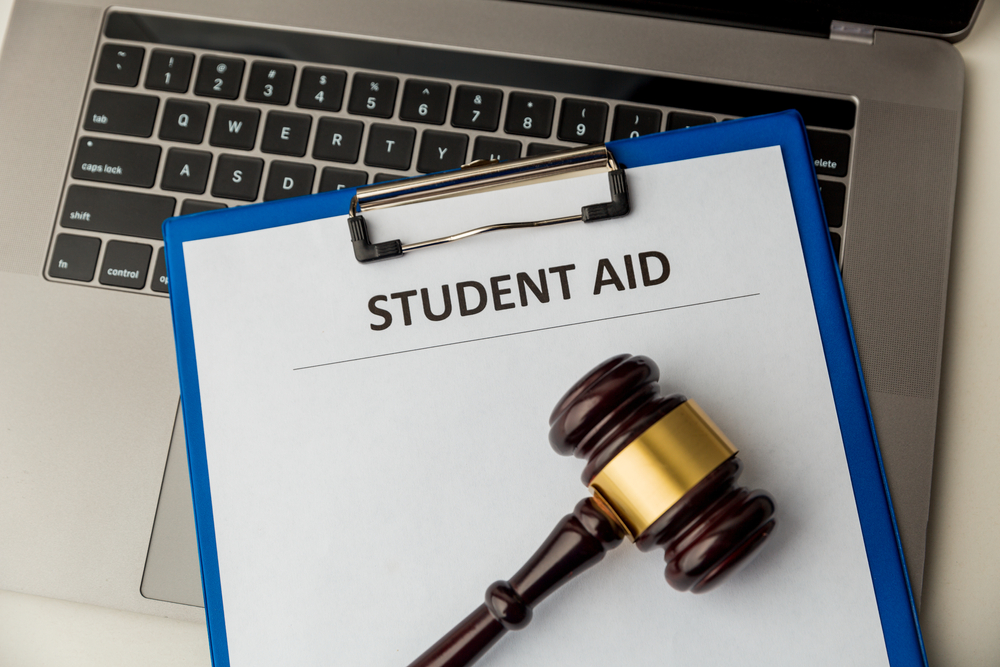Secondary education offers opportunities and a pathway to success in a chosen career, but paying out-of-pocket for tuition, housing, and related expenses is beyond the financial means of many people. Therefore, many who seek degrees will choose to fund their schooling through student loans, many of which carry favorable terms and interest rates. Both public and private options are available, and the borrower makes monthly payments against the balance.
However, a wide range of adverse events and circumstances could put you in a poor position in terms of repayment. You might consider the student loan as being lower in priority, so you cover other monthly bills first. Some borrowers could miss a payment, expecting to catch up when finances improve. Unfortunately, in many cases, the end result is falling behind with both regular bills and student loan payments.
Fortunately, bankruptcy offers an opportunity to eliminate or reduce your debt, allowing you to look forward to a brighter financial future. When your debt includes student loans, you may wonder what happens to them in bankruptcy. The details vary according to your situation, so it is wise to consult with an Arizona bankruptcy lawyer who can provide personalized advice. You might also benefit from checking out a legal summary of the relevant concepts.
Options to Discharge Student Loans
Bankruptcy is a legal process that either eliminates your debt or restructures it into a plan that pays back your creditors over time. The US Bankruptcy Code treats various types of debt differently through the proceedings, and some cannot be discharged at all. Many people believe they cannot get rid of student loans, but this is a misconception. It is possible, though extremely challenging because of the legal requirements.
When you are seeking to eliminate student loans, the bankruptcy court will go through a very detailed analysis to consider your request. There are three points to note:
- You must go through an adversary proceeding to have the court determine how to treat your student loans, in addition to the typical steps of bankruptcy.
- To assess whether to discharge student loans, the judge will consider the concept of undue burden.
- Undue burden depends, in part, on whether you can maintain a minimal standard of living.
Overview of the Bankruptcy Process in Arizona
Though student loans are subject to special rules, the basics of bankruptcy laws do not change. The first step in the process is to file for bankruptcy under the chapter that is most appropriate for your situation. For individual filers, the most common options are:
Chapter 7: With Chapter 7, you discharge qualifying debts and will not have to pay creditors back. This is an extreme remedy from the point of view of a creditor, so there are strict rules on who qualifies for Chapter 7. You must either be below the median income in the state of filing or satisfy the means test, which calculates what you have left after paying for living essentials. Note that a bankruptcy trustee has the power to liquidate assets, selling them off to get the cash to pay creditors.
Chapter 13: If you do not qualify for Chapter 7 or want to protect assets, you might consider a Chapter 13 debt repayment. Instead of debts being discharged, they are converted into a plan where you pay creditors back a portion based on what you can afford. Once your repayment plan is complete, debts are discharged even if you did not pay in full.
Adversary Proceedings on Student Loans
After filing for Chapter 7 or 13, you will take the next steps by requesting an adversary proceeding regarding your student loans. This process is akin to a trial within your bankruptcy case, in which you ask the court to take special action by discharging a specific type of debt. It is critical to get assistance from an Arizona bankruptcy lawyer, as litigation involves complex laws and rules.
The standard for granting your request is whether you and your dependents would suffer an undue burden if you have to pay back the student loan. Your goal in the adversary proceeding is to prove that you would. The basic process works as follows:
- You file a “complaint,” which is your request for the bankruptcy court to make a decision on your student loans. In it, you state the facts of your case, including evidence of undue burden.
- After a response to your complaint is filed, you go through the typical steps of other types of litigation. The parties can engage in discovery to get more information from each other.
- At the adversary proceeding, the parties each have the opportunity to present exhibits, documents, and witness testimony to the court.
- After hearing the evidence, the bankruptcy court makes a decision on your student loans.
Two Tests for Undue Burden
The primary focus at your adversary proceeding is whether there would be an undue burden on your household if you did not receive a discharge on student loans, and the court uses two tests. The first is based upon a prior court case, and the decision is followed by many judges. To prove undue burden, you need to show three sets of facts:
- You are unable to maintain a minimal standard of living for yourself and the dependents you support.
- Your financial condition will not improve during the loan repayment period.
- You meaningfully, and sincerely attempted to repay your student loans before filing for Chapter 7 or Chapter 13.
The second test uses the totality of the circumstances to evaluate undue burden. The court looks at the big picture on your student loans, but will not give as much weight to whether or not you tried to pay them back.
Factors for Minimal Standard of Living in Arizona
With the first test described above, a minimal standard of living is a key factor. However, this concept may also be important when bankruptcy court judges apply the totality of the circumstances test. The minimal standard of living is a discretionary call, but you might convince the court if:
- Your income is and has been below the federal poverty rate, and it is not likely to change.
- You suffer from a permanent or long-term disabling or debilitating medical condition.
- You are the caregiver for a spouse who has a disability.
- You rely on public assistance, SNAP, or food stamps to support your family.
Advantages of Student Loan Discharge
If you are successful at the adversary proceeding and prove that your student loans are an undue burden, the outcome depends on the type of bankruptcy you filed. The amounts might be wiped away completely with Chapter 7. With Chapter 13, you might pay back a reduced amount as part of your debt repayment plan.
With both options, there are distinct benefits over the alternatives offered by lenders and student loan services. When you take out a public loan and certain private loans, you might hear about forbearance, deferment, and income-driven repayment plans for those in difficult financial situations. These might seem like attractive options as compared to bankruptcy, but consider them carefully.
With forbearance and deferment, the lender grants a pause on your student loan monthly payments. However, you still owe the full amount. Plus, with forbearance, you will continue to accrue interest during the pause. Income-driven repayment reduces your monthly payment to an amount that aligns with your earnings, but you could be making payments for 25 years or more.
Additional Benefits of Bankruptcy
Eliminating or reducing your student loans through bankruptcy is certainly the most impactful benefit, but there are others. In fact, even if you are not successful at your adversary proceeding, you can still experience the advantages. With Chapter 7, you are no longer paying on other debts that were discharged. Chapter 13 reorganizes your debt. Both options could potentially free up funds that could be applied to your remaining student loans. Plus, while you did not prevail at the adversary proceeding, it might now be appropriate to consider forbearance, deferment, or income-based repayment plans.
Still, there are many other benefits of using bankruptcy to address debt:
- Upon filing your bankruptcy petition, there is an automatic stay on all creditor actions. They cannot call, sue, garnish wages, or attack property.
- You are no longer making payments on accounts without even touching the underlying balance. There is no longer the frustration of paying the amount due, but it all goes toward fees and interest.
- You emerge debt-free from bankruptcy, empowering you to start building your credit and financial foundation.
- As part of the bankruptcy process, you will be required to go through debt counseling. These sessions are informative and provide you with the tools you need to avoid falling back into financial hardship.
- Though bankruptcy remains on your record for a period of years, you will get better interest rates on future loans.
Your credit record will reveal a Chapter 7 case for 10 years, and Chapter 13 will be part of your credit score for 7 years. The implications may seem harsh, but the benefits are significant.
Discuss Options with an Arizona Bankruptcy Attorney
Any bankruptcy case can be challenging, but the complexities increase when you are seeking to discharge student loans. You are in a better position to obtain a favorable outcome at the adversary proceeding when you have representation, so please contact DebtBusters to learn more about our legal services. You can reach our Scottsdale, AZ office at (866) 223-4395 or via our website. We can schedule a consultation with a knowledgeable lawyer who will provide additional details on what happens to student loans in bankruptcy.
Related Content: How Long Does It Take To Get a Discharge?







